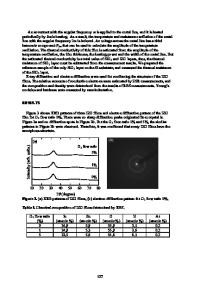Integration of Zinc Oxide Thin Films with Polyimide-based Structures
- PDF / 310,326 Bytes
- 6 Pages / 612 x 792 pts (letter) Page_size
- 59 Downloads / 326 Views
D1.7.1
Integration of Zinc Oxide Thin Films with Polyimide-based Structures Masashi Matsumura1, Zvonimir Bandic2, and Renato P. Camata1 1 Department of Physics, University of Alabama at Birmingham, Birmingham, AL 35294, U.S.A. 2 Hitachi Global Storage Technologies, Inc., San Jose, CA 95120, U.S.A. ABSTRACT Zinc oxide (ZnO) films were deposited on polyimide-based substrates by pulsed laser deposition. The ZnO films and the underlying polymer layers were studied using Fourier Transform Infrared (FTIR) and Photoluminescence (PL) spectroscopies. FTIR measurements in structurally well-characterized samples exhibiting all X-ray reflections of crystalline hexagonal ZnO show absorbance bands around 405 cm-1 (Zn-O stretching vibration) and 1110 cm-1 (in-plane C-H vibrations on aromatic rings of polyimide). Observed shifts in both absorption features as a function of deposition temperatures can probably be attributed to thermal stress in the layers. PL measurements showed broad spectra centered around 3.35 eV from ZnO excitonic emission and a broader PL band from 2.7 to 3.1 eV defect complex emissions. The appearance of these peaks was consistent for depositions of ZnO on non-organic substrates, which indicates that the integration of ZnO thin films on polymer based substrate preserved the characteristic optical properties of ZnO. INTRODUCTION ZnO has a wide band gap of 3.37 eV at room temperature, and has large exciton binding energy (59 meV), which shows excitonic effects even at room temperature. With its hexagonal wurtzite structure, ZnO is piezoelectric [1], has ferroelectric properties when doped [2], and often exhibits n-type conductivity [3]. By taking advantage of these characteristics, ZnO is widely used in various technological applications such as surface acoustic wave devices, pyroelectric sensors, piezoelectric devices, gas sensors, and varistors among others. ZnO is particularly attractive for monolithic instruments because it is relatively easy to obtain good quality polycrystalline films with moderate Hall mobilities (>1 cm2/V s) at room temperature [4]. This affords this material good compatibility with plastic or flexible substrate materials. Since ZnO is transparent in the visible, it is also compatible with a variety of applications in flexible photovoltaics [5]. ZnO has attracted attention not only as a thin film semiconductor material, but also in exquisite nanoscale configurations [6]. This is a result of the recent demonstration of numerous methods for ZnO nanostructure synthesis. Several developments remain to be achieved, however, if ZnO is to become a reliable commercial semiconductor material. These include advances in bulk and epitaxial growth [7], p-type doping [8], and high quality integration to polymer platforms. In this paper a study of the microstructural and optical properties of ZnO films integrated onto polymer-based substrates under different film deposition conditions was performed in order to evaluate the possibility of future monolithic devices that combine the properties of ZnO fil
Data Loading...











